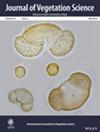Islanded Islands: Dual Isolation Drive Distinctive and Threatened Floras of Neotropical Maritime Inselbergs
Abstract
Questions
Inselbergs, isolated rock outcrops, support unique plant communities. Maritime inselbergs (MIs) experience transient isolation due to maritime fluctuations, creating harsh survival conditions. This study is the first to investigate the plant communities' patterns on MIs, comparing them with those on continental inselbergs (CIs). We explore how oceanic filtering and climatic factors shape species and phylogenetic diversity, the threatened statuses of the species, and the impact of extinction scenarios on phylogenetic diversity and structure.
Location
MIs and CIs in the Atlantic Forest of Southeast Brazil.
Methods
We analyzed species and phylogenetic patterns across 15 inselbergs (nine CIs and six MIs), including new data from Alcatrazes Island. Floristic dissimilarities were assessed using ward's clustering, and species and phylogenetic relationships were explored through NMDS ordination and phylogenetic PCA. Oceanic filtering and climatic factors were evaluated using convex hulls and bioclimatic variable fits. Phylogenetic diversity (PD) and structure, measured as mean pairwise distance (MPD), were assessed, along with species threat status based on the Brazilian Red List. Simulated extinction scenarios, randomly removing 5%–90% of species, were modeled to evaluate effects on phylogenetic metrics.
Results
MI species and phylogenetic composition differed significantly from CIs, influenced by oceanic isolation, isothermally, and precipitation seasonality. We found no significant difference in PD between CIs and MIs. Only 11% of the 753 species were shared, with 10% classified as threatened. PD decreased with increasing extinction rates (p < 0.01, R2 > 0.7) across all communities. MIs exhibited clustered phylogenetic structures, while CIs showed random structures. Random extinction sharply reduced PD, and phylogenetic structures were disrupted in all communities at 25% extinction.
Conclusions
We introduce the concept of MIs, demonstrating that their flora differs significantly from CIs due to oceanic isolation and climatic factors. Although historically connected, geomorphological conditions, subsequent isolation, and environmental filtering by the sea have led to a unique maritime species and phylogenetic composition. Extinction scenarios show significant declines in PD, highlighting these ecosystems' vulnerability. The distinct flora and loss of PD emphasize the need for targeted conservation efforts.


 求助内容:
求助内容: 应助结果提醒方式:
应助结果提醒方式:


